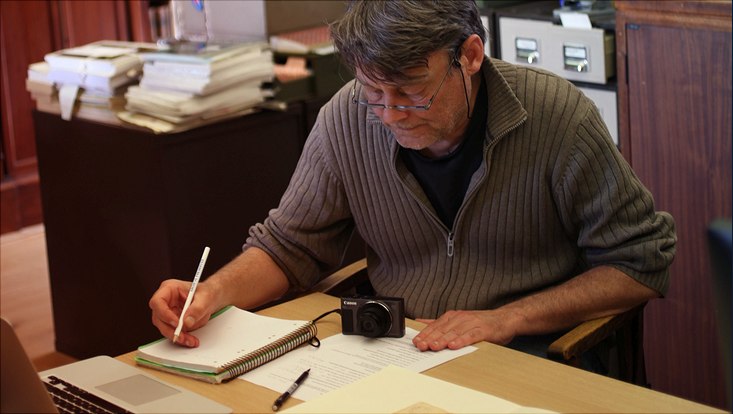Prof. Dr. Staffan Müller-Wille

Curriculum
Staffan Müller-Wille is University Lecturer in History of Life, Earth and Human Sciences at the Department for History and Philosophy of Science, University of Cambridge, and also holds an honorary chair at the Institute for Medical History and Science Studies, University of Lübeck. He received his PhD in Philosophy from the University of Bielefeld in 1997, and worked afterwards at the German Hygiene Museum in Dresden and the Max Planck institute for history of Science in Berlin. In 2004, he moved to the University of Exeter (UK), where he last held a position as Associate Professor in the History and Philosophy of the Life Science and Co-Director of Egenis – The Centre for the Study of the Life Sciences. From 2013 to 2018, he was Editor-in-Chief of the journal History and Philosophy of the Life Sciences. He has held fellowships in Tel Aviv, Mexico City, Paris, Minneapolis, Berlin, Bielefeld and Uppsala. His research falls within two broad themes, the history of natural history with a focus on the work and legacy of Carl Linnaeus (1707–1778), and the cultural history of heredity since the early modern period with a focus on classical genetics and racial anthropology. He is chiefly interested in the history of information processing technologies in these areas, and how these have shaped our view of the world. More information on his research and publication can be found here: https://www.people.hps.cam.ac.uk/index/teaching-officers/muellerwille
Publications (selection)
- "‚Jederzeit zu Diensten’: Karl Ludwig Willdenows und Carl Sigismund Kunths Beiträge zur Pflanzengeographie Alexander von Humboldts”, in: edition humboldt digital, ed. by Ottmar Ette (Berlin: Berlin-Brandenburgische Akademie der Wissenschaften, https://edition-humboldt.de/v4/H0017685)
- “Names and Numbers: ‘Data’ in Classical Natural History, 1758–1859”, in: Data Histories, ed. by Elena Aranova, Christine von Oertzen and David Sepkoski (=Osiris, vol. 32) (Chicago: University of Chicago Press, 2017), pp. 109–128.
• “Linnaeus and the Love Lives of Plants”, in: Reproduction: From Antiquity to the Present Day, ed. by Nick Hopwood, Rebecca Flemming and Lauren Kassell (Cambridge: Cambridge University Press, 2018), pp. 305–318. - Handbuch Wissenschaftsgeschichte, ed. with Marianne Sommer and Carsten Reinhardt. (Stuttgart: J. B. Metzler, 2017)
- “Linnaeus and the Four Corners of the World”. in: The Cultural Politics of Blood, 1500–1900, ed. by Kim Coles et al (Basingstoke: Palgrave MacMillan, 2015), pp. 191–209.
- A Cultural History of Heredity. Chicago: University of Chicago Press. With Hans-Jörg Rheinberger. (Chicago: University of Chicago Press, 2012)
Reserach project: Affinities. On the history of a transdisciplinary concept around 1800
In the eighteenth and early nineteenth centuries, the concept of affinity (Lat. affinitas, Germ. Verwandtschaft) experienced several conjunctures in the natural sciences. Beginning with Étienne François Geoffroy’s Table des rapports (1718), the concept played a crucial in the chemical revolution; affinity referred to the capacity of substances to displace other substances from compounds. In this sense, transmitted by Torbern Bergman’s Dissertation on Elective Attractions (Engl. 1785, Lat. 1775), the concept also entered world literature in Johann Wolfgang von Goethe’s novel Die Wahlverwandtschaften (1809; translated as Elective Affinities or Kindred by Choice). Alongside this chemical tradition, the concept was also routinely used by naturalists – primarily Carl Linnaeus, but a good century later by Charles Darwin – to refer to relationships of morphological similarity that so-called “natural systems” of plants and animals displayed. The concept finally also played a role in writings about electricity and magnetism, and in speculations bout the generation and development of organisms. Occupying a position at the threshold between the living and the non-living, affinities referred to relationships of both form and force. The aim of my project is, in the first instance, to chart the semantic space of affinity, as well as the main lines of its historical development. A particular focus will lie on its genealogical and political connotations, and on the translation of the concept into a multitude of tabular and diagrammatic representations.
Research results: Affinities. On the history of a transdisciplinary concept around 1800
The concept of affinity (lat. Affinitas, germ. Verwandtschaft) played a prominent role in the sciences of nature in the 18th and early 19th centuries. It was especially significant for the chemical revolution; chemists used the term affinity to designate the capacity of a chemical substance to dis and re-place another substance from a compound. In this sense, the concept also entered world literature through its adoption in the title of Johann Wolfgang von Goethe’s Die Wahlverwandtschaften (Elective Affinities; 1809). But alongside, the concept was also used in natural history for relations of similarity within the “natural system” of organisms, and also appeared in the speculative literature on electricity and magnetism, as well as generation, development and reproduction of organisms. The purpose of my project was to map the semantic space of affinity and the main lines of its historical development, first through a review of the extant literature, and secondly through a case study focussing on the work of the Hamburgian naturalist Paul Dietrich Giseke (1741–1796). In this, particular attention was paid to the genealogical and political connotations of affinity, and to its diagrammatic visualisations. A main result of these undertakings is the hypothesis that affinities, occupying the threshold between anorganic and organic nature, not only designated formal relations of similarity, but pointed to a field of hidden, antagonistic forces, drives or tendencies, from which relations of form would emerge in the first place.
